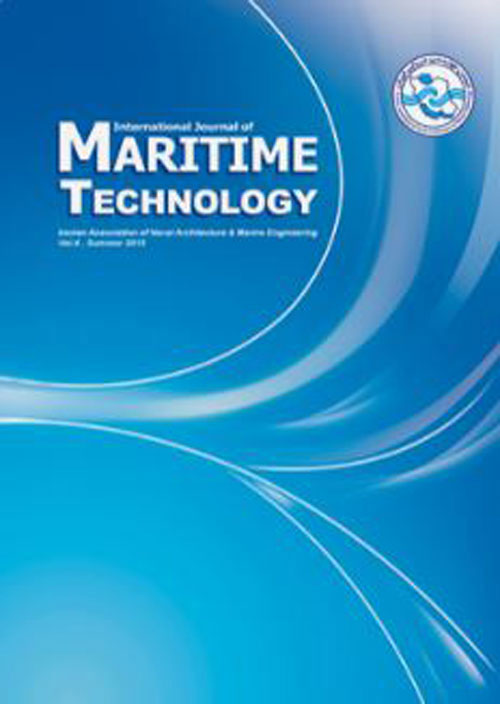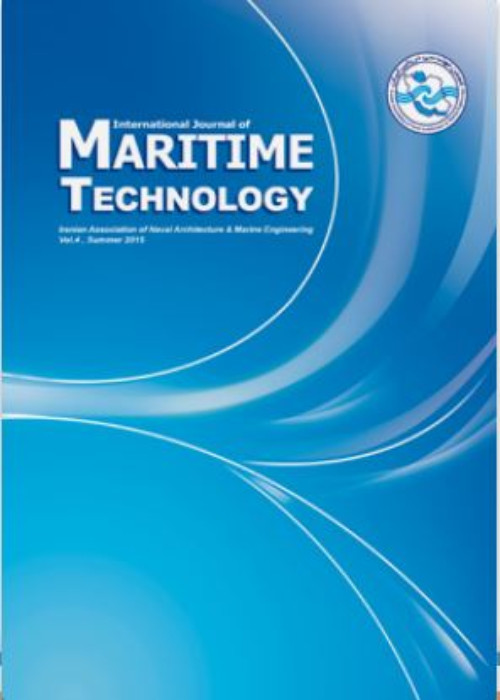فهرست مطالب

International Journal of Maritime Technology
Volume:9 Issue: 16, Spring-Summer 2021
- تاریخ انتشار: 1401/01/21
- تعداد عناوین: 7
-
-
Pages 1-12
Offshore oil and gas extraction structures at shallow waters are conventionally supported by long driven steel pipe piles. In recent years, the direct CPT- or CPTu-based pile design methods have broadly been used to predict the bearing capacity of offshore piles in a more reliable manner. On the other hand, previous investigations have shown that the pile capacity is time-dependent (set-up and relaxation phenomena). However, time effects are missing in most CPT- or CPTu-based prediction methods. The main objective of this paper is to estimate the axial compressive bearing capacity of the offshore steel pipe piles driven in the marine clay deposits of the Persian Gulf based on some popular CPT/CPTu as well as static -based prediction methods. The estimated results are compared with the measured capacities obtained from the Pile Dynamic Analyzer (PDA) and the Case Pile Wave Analysis Program (CAPWAP). The measured values have been recorded at End-Of-Drive (EOD) and Beginning-Of-Restrike (BOR) conditions periodically up to nine months after pile installation. Then, the most reliable bearing capacity prediction methods are determined based on the shaft, base, and ultimate capacity values in short, medium, and long-term conditions. Here, five open-ended long steel pipe piles driven into very soft to hard marine clays of the Persian Gulf, Iran are considered to verify and evaluate the prediction quality of each method. It is shown that the ratio of predicted to measured ultimate bearing capacities obtained from the static analysis methods averagely have around 64% more scattering than the corresponding values obtained from the CPT and CPTu-based methods. The results of the current investigation can be employed in offshore piling projects of the Persian Gulf in which the time constraints of installation do not allow running dynamic load tests at different time intervals.
Keywords: Offshore pile, Bearing capacity, CPTu, PDA test, Time function, Set-up -
Pages 13-27
The efficiency of ports and container terminals is strongly related to the process of loading containers onto and unloading containers from the docked ships. In this research, an issue of integrated equipment management in automated container terminals with the aim of increasing efficiency has been studied. Due to this issue falls into NP-Hard problems, it was divided into two sub-problems: Allocating resources to containers and arranging the containers serviced by automated guided vehicles. Both sub-problems were formulated and expressed using the linear integer-programming model. The first sub-problem is solved by the allocation of random process resources with uniform distribution and the second part is solved using a Sorting Genetic Algorithm. The main parameters of the proposed solution methods were determined with Minitab software and Taguchi techniques. In order to evaluate the efficiency and effectiveness of the proposed solution methods, many numerical experiments have been examined and evaluated. The experimental results show that the proposed solutions are efficient for estimating the service time and the number of automated guided vehicles required to transporting the containers in the container ports.
Keywords: Automated Container Terminal, Automated Guided Vehicle, Quay, Crane, Yard Crane -
Pages 29-40
The jacket structure is the key facility for the exploitation of marine resources. Offshore oil platforms located in an earthquake zone need to be analyzed for the structural response. A real offshore structure is always intricate and has to be idealized to diverse degree to fit in to the framework of the mathematical model for dynamic analysis. This work addresses the need for such a facilitated structural computation model. The planned scheme is based on laboratory work for improving the facilitated model. This study describes the scheme in employing the MDC associated with the GA method to create and update the facilitated structural model for analyzing the responses of a jacket platform. The facilitated modelling is first calculated based on MDC method, and then the platform model is refined and improved based on recorded modal features. Considering the presented model, the expense of analysis of jacket offshore structures is considerably reduced without incurring any loss of precision. Therefore, improvement of such approaches would be acutely beneficial to spread out technologies that can be applied for jacket structures with saving of both time and cost.
Keywords: Jacket offshore platform, Vibration experiment, Mixed-dimensional coupling (MDC), Model updating, Genetic Algorithm (GA) -
Pages 41-52
Oil, gas, and petrochemical facilities are strategic industry facilities, and their passive defense issues are of high priority in every country. Explosions due to sabotage or aerial bombardments are the most critical factors in considering issues related to passive defense in the abovementioned facilities. This study investigates the effect of blast loading on pressure vessels. The research issue is the study on the interaction between factors that affect on responses of pressure vessels under blast loading. For this purpose, the response surface method and central composite method were used for numerical design tests. Four factors were selected, type of pressure vessel (vertical or horizontal), the thickness of vessel body, the yield strength of steel vessel, and the amount of explosive material. Two responses were studied, the maximum displacement of pressure vessels and the residual displacement of pressure vessels. The result shows that the quadratic equation is the best model for equations. Then for two responses according to the four factors presented equations. These equations are practical, and straightforward for engineers and researchers. The result shows that for both of the selected responses, the role of body thickness and type of steel in the stronger explosion is the same, but in the weaker explosion, the role of yield strength increased. In addition, it was found that role of the amount of explosive material is more than another parameter. And the interaction of material explosive by other parameters in vertical type is more than horizontal pressure vessels.
Keywords: Pressure Vessel, Oil, Gas Facilities, HE Explosion, RMS method, Passive Defense -
Pages 53-61
A clear understanding of marine traffic complexity is vital for safe and efficient navigation inside ports (e.g., pilotage inside the basin). Built on statistical analysis of vessels’ speed and course over ground extracted from satellite-based Automatic Identification System (AIS) data, an index of maritime traffic situation is developed in this research. After zoning the port basin, this index is calculated at each zone based on a combination of statistical measures (e.g., mean and standard deviation of speed and course over ground), in which vessels’ class based on their size and targeted pier is also incorporated. The model could effectively increase the situational awareness by simple monitoring of navigation activities and reflecting improvements. This becomes possible by identification of high opportunity and high risk zones, i.e., those with high index value which call for operation modification which are far from and close to the infrastructures (e.g., breakwaters), respectively. To explore the model outcome, it is typically applied on the Rajaee port - the largest port of Iran located in the Persian Gulf - and output are discussed with port’s maritime operators to analyze results. This resulted in identification of challenging zones for which pilotage plans could be improved. Also, it provided insight for better implementation of the basin which also could be considered in future development plans of the port.
Keywords: Traffic randomness, Situational awareness, AIS data, port performance problems, safety -
Pages 63-71
According to the important rule of maritime transport in world trade and prevent the further emission of greenhouse gases, ships' propulsion system needs innovative designs. One of these plans was the rotor sail introduced in recent decades. This idea uses wind power to help propulsion ships and is based on the Magnus effect, which Anton Flettner proposed. The selected geometry is based on the experimental tests performed at Reynolds number 5800 for speed ratio 0 and 4 simulated. The numerical solution has been done by the CFD method, and the results of lift and drag coefficients are obtained and validated. The results show that by changing the body form, the behavior of fluid around it also changes and leads to a different distribution of velocity and pressure. For both models with a stationary cylinder, CD=0.67 and for the first rotational model, CL=6.35 & CD=1.076 and for the proposed form, CL=6.041 & CD=1.039.
Keywords: Rotor sail, Magnus effect, Flettner, Numerical analysis, Wind assisted ship propulsion -
Pages 73-85
XBeach is designed to model nearshore area in storm conditions and needs adjustments to be used for longer periods. One way to implement this model on a medium- or long-term time scale is to take the model through a calibration step. Selecting the right calibration factors amongst several parameters can be challenging. In this study, ten factors were selected based on the literature review to determine the extent and nature of their impact on the transformation of the sandy profiles of Zarabad fishery harbor in seven months (2006.02.20 to 2006.09.23). By 2DH modeling, the results are represented by two profiles from the study area. Six of the ten selected parameters had a significant effect on the behavior of the profiles, and the results of seven out of ten parameters showed a convergence point in their profiles. As a result of this study, it is possible to move more consciously and expedite the calibration process of further studies. Of course, changing the particle size, the beach slope, the modeling duration, and the energy level of the incoming waves in the area may lead to different results, which can lead to further studies.
Keywords: Sensitivity Analyzes, Sandy beach, Sedimentation, Bed level change, Process-based modeling


